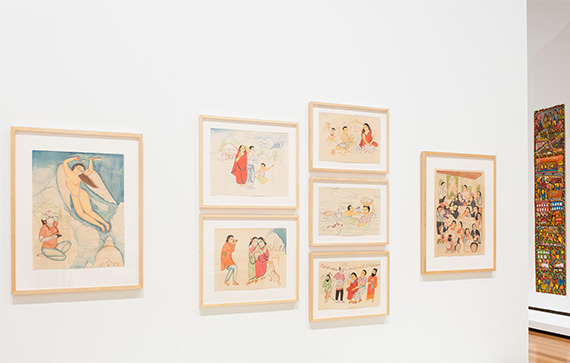
Kalam Patua is a contemporary exponent of Kalighat painting. He was born into the Patua community of scroll painters and storytellers and subsequently taught himself the Kalighat style, which draws on conventions from West Bengal scrolls and Indian miniature painting. Kalighat painting developed in the vicinity of the Kali temple in Kolkata (formerly Calcutta) in the mid nineteenth century to illustrate the Hindu Pantheon and respond to topical social and political events relevant to a local audience. At this time, many Patua artists migrated to Kolkata as the sale of illustrated works provided a more secure income than the itinerant performing associated with the scrolls. Kalighat painting was intended for a larger audience and departs from the linear, narrative style of the scrolls to focus on single scenes with graphic, simplified forms and often satirical, contemporary content.
Kalighat painting declined as cheaper wood prints and then machine-printed images became more desirable to tourists visiting Kolkata. There are few artists painting in this style today. Patua works as a postmaster in a rural post office in West Bengal and produces works in his spare time. His unique watercolours contain elements of autobiography and myth, and reflect on social issues or current news events. Topics have ranged from the changing nature of Indian society, dowry deaths or violence against women, to light, humorous works, including a series about working in the postal system, to depicting crowds that gather in public areas.
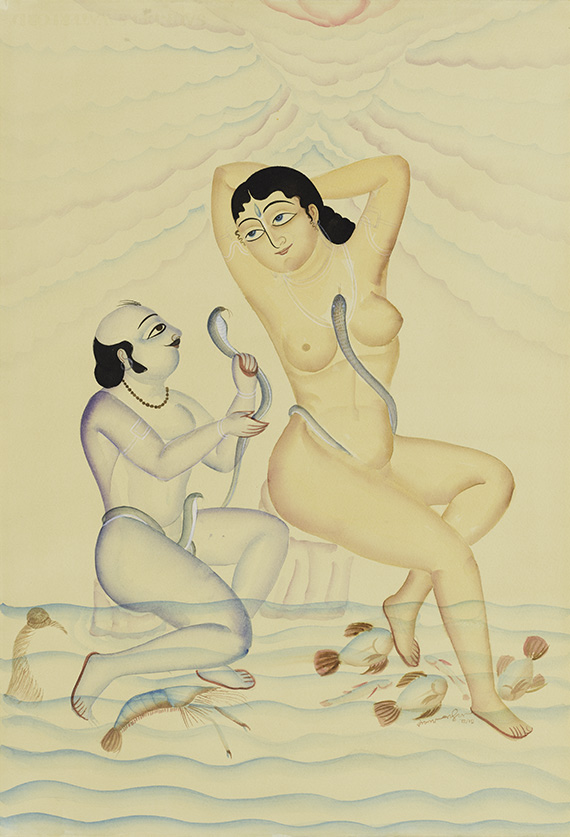
Snake charmer playfully explores sexual attraction and union. In Hindu iconography, snakes often represent divinity and the legend of Manasa Mangala, the snake goddess, is especially popular in West Bengal. For Patua, the snake charmer also has a personal and historical dimension. His ancestors were patua or scroll artists, who often practised alternative trades to supplement their incomes, from making clay idols (like his uncle and aunt), to performing magic tricks, pyrotechnics and snake charming. The artist consciously mixes religious symbols with earthly ones in this painting. The male figure has the blue skin of Krishna, and the delicately painted sky with its stylised clouds also suggest divinity, contrasting with the balding, earthly figure attempting to seduce the posing beauty.
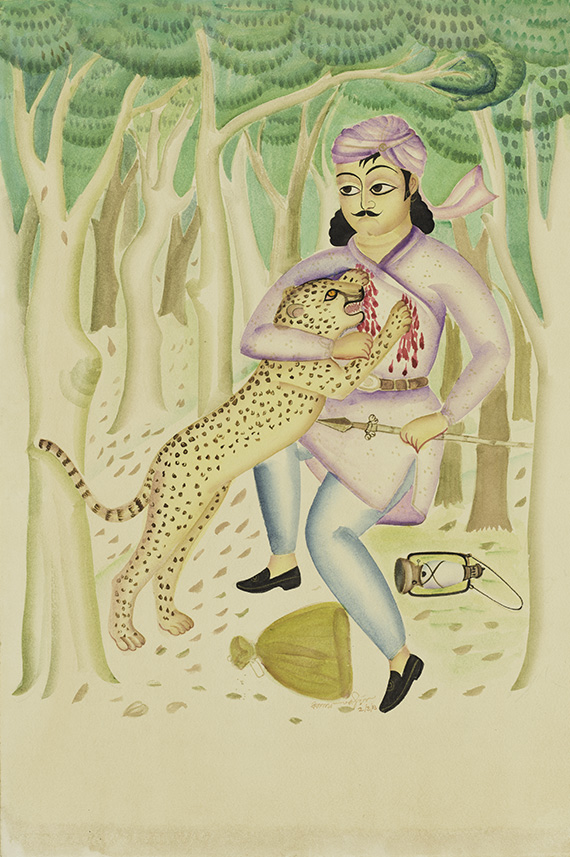
The Post Office belongs to a recent series by Kalam Patua on the history of the postal system. Patua has been employed in the system for most of his adult life, primarily working in remote West Bengal branches and only pursuing his passion for painting at night. He was once transferred to a branch that was far from his home, leaving him no opportunity to paint. However, after the chief postal officer read a magazine article on Patua’s work he was transferred back to his former office. On Post office 3 Patua comments ‘In earlier days, runners would carry the daak (mail) from one area to another and would face enormous problems and dangers including wild animals. This work pays tribute to those runners who dedicated their lives to delivering mail at any cost.’
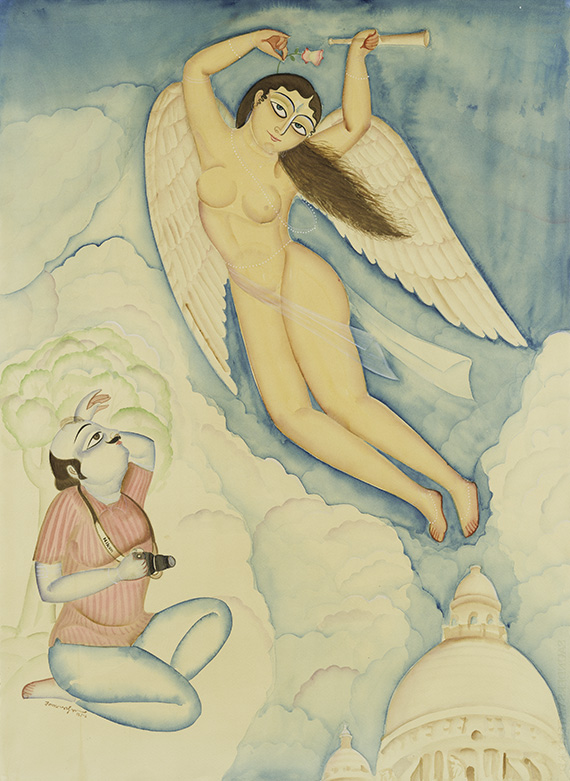
Photography and Kalighat painting were rival professions in the expanding metropolis of Kolkata in the 19th century. Both share a common attention to current affairs, or to capturing a moment within the artist’s surroundings. Kalighat painting flourished from the early 1800s for almost a century, but fell into decline after the advent of the more easily reproducible lithograph and photograph. Eventually, the children of Kalighat painters migrated to other professions, and the last Kalighat painter is reported to have died in 1930. Patua has created a number of works and series about photography and associated ideas of self-representation. Beyond reach explores the power of dreams and humanity’s desire for things that are out of reach. It was inspired by the angel sculpture on the roof of the Victoria Memorial Building in Kolkata. Patua has imagined the angel coming to life, soaring above a kneeling tourist who attempts to capture her with his camera. This work is part of an extended series entitled ‘Photography’, showing the same small, blue-skinned figure holding a camera, who is often overshadowed by the larger-than-life subjects he encounters.
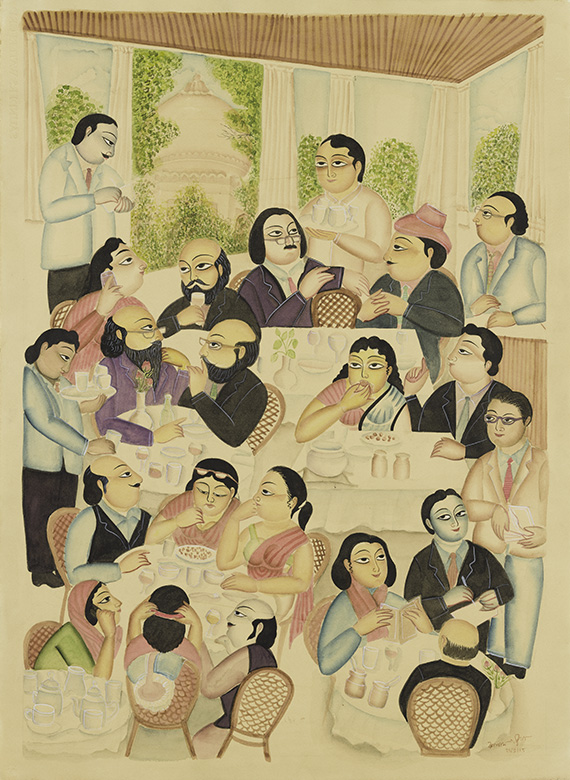
Kalighat painting developed in the southern district of Kalighat in Kolkata, near a temple dedicated to the Hindu goddess Kali. Many scroll painters from West Bengal opened shops there and began painting this different form of artwork, as the demand for single images was more lucrative than the long scrolls. In addition to religious subjects, these artists also became known for their satirical observations of society in Kolkata of the period, with its English sahibs riding elephants; wealthy Calcutta babus (liberalists), who were shown as immorally squandering wealth; and charlatan holy men or sadhus succumbing to base desires. In Restaurant Patua continues the Kalighat observation of contemporary society, showing the crowds gathering at a local restaurant, with its obsequious waiters, bearded intellectuals, a blue-skinned man wearing a business suit, and dreamy young women seated in the foreground.
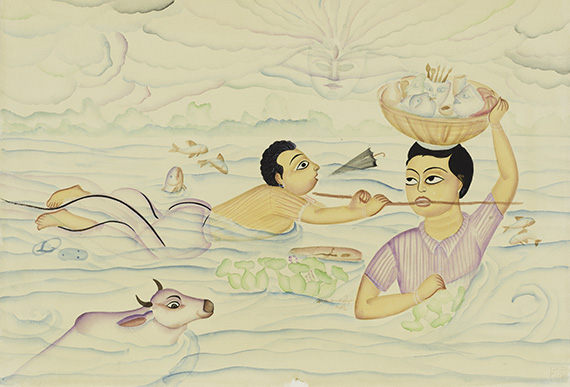
Patua’s ‘Autobiography’ series details various events from his life and childhood. In one, he is a young boy pointing to an aeroplane flying in the sky; he tells his parents he will fly in it one day, and they smile at his ignorance. Later, Patua was able to take several plane journeys but not until after the death of his parents. Other paintings illustrate his life growing up with his uncle and aunt, artisans who made clay idols. Autobiography – Caught in the flood shows Patua at 16 and his uncle on their way to sell the idols, crossing a river flooded by a monsoon; Patua held a stick that his uncle carried in his mouth so he wouldn’t be swept away.
Several hundred indigenous and rural-based communities exist in India, varying greatly in ethnicity, culture and language. Kalpa Vriksha is a Sanskrit term for a divine or wish-fulfilling tree. Mentioned in scriptures, it is also used to describe living, sacred trees that embody the everyday and the mythical, the ancient and the contemporary. Communities such as the Warli, Gond and Patachitra scroll painters and Mithila artists are known for vibrant visual techniques incorporating ancient histories, while Kalighat painting and clay sculpture from the Rajwar community have developed as part of daily life and belief. Phad painting and Kaavad shrines are part of storytelling traditions drawing on song and performance. The ‘Kalpa Vriksha: Contemporary Indigenous and Vernacular art of India’ project in APT8 shows how today’s artists experiment with these traditions, capturing the way traditional iconography and techniques have developed, and how new styles are used to explore contemporary issues. Developed for APT8 with assistance from Delhi-based curator Minhazz Majumdar.
The Asia Pacific Triennial of Contemporary Art (APT)
is the Gallery’s flagship exhibition focused on the work of Asia, the Pacific and Australia.
21 November 2015 – 10 April 2016
Exhibition Founding Sponsor: Queensland Government
Exhibition Principal Sponsor: Audi Australia

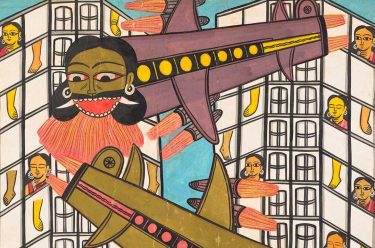
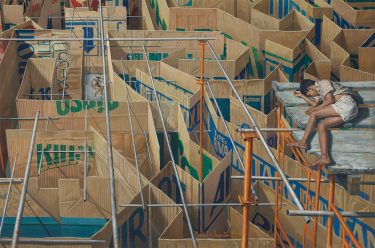
I am very much lucky to have u as my guru sir .I am a 7th class student of k v BOLARUM Hyderabad. I have learned the beautiful art by you sir. I met you in spic macay online class. I want to learn more about this art how can I approach you sir or any guidance can you tell me how to improve my passion in this field